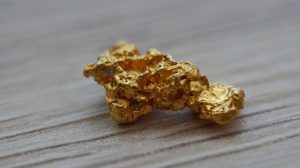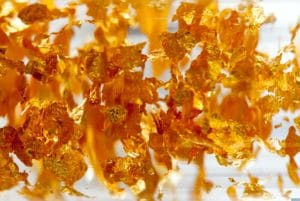
“Hey, let’s go get some gold!”
If you were around in the 1800s this would have been a perfectly natural thing to say.
Gold was abundant and easily accessible to anybody who wanted it.
As time went on however, people started finding out that all of this gold wasn’t as easy to get as they had originally thought.
They would dig through mountains, swim in the rivers and even go to war over a single piece of gold.
Today we find ourselves in a similar situation.
Gold isn’t so easy to get anymore and acquiring it comes at a much higher price than it used to be.
A little bit of science on Where Gold began
Let’s start by giving you a little bit of background information on gold and how it formed in the first place.
It turns out that every once upon a time, there was nothing but hydrogen and helium gas left over from the Big Bang.
No matter, right? Well… no actually.
At some point, gravity formed these hydrogen and helium atoms into clouds which eventually collapsed in on themselves, igniting the star that you see every night when you look up into the sky.
The heat of this fusing process released even more particles, turning everything into heavier metals including gold.
So how do we get to this shiny yellow metal?
Let’s start by looking at the planet Earth.
Our planet is located in a very special place in our solar system, where it meets three circumstances that are crucial to life as we know it:
The distance to the sun makes life possible because there’s enough sunlight for photosynthesis.
There’s an abundance of water on earth, a necessity for life.
The core is solid, made from iron and nickel, rich in nutrients.
In theory, this would have been enough to create gold deposits somewhere on earth.
Unfortunately, that’s not what happened.
Gold is extremely rare because it doesn’t liquefy until 1064.15 degrees Celsius, more than twice as hot as our sun, which could vaporize all earth’s gold before it had a chance to be turned into liquid.
Extracting Gold
There was only one way that we were going to get any gold from earth: through man-made means.
The first way that people began extracting metals from the ground, was using mercury, and this method actually worked pretty well.
The thing was that it just wasn’t efficient enough and any people who used it would come up empty handed.
Using Cyanide
By 1947, we had started using cyanide to separate the gold from the ore and this worked much better than mercury did: we could obtain 0.5 grams of gold for every ton of rock that we processed!
This new method is still being used today, but with better magnets which have an even higher gold concentration.
This new method though required a lot more energy and it wasn’t cheap, so many of the small mining companies went bankrupt or had to sell their land to the bigger companies that could afford all the equipment necessary for this process.

The Leaching Method
The same thing happened with the only other way that we had of extracting gold before cyanidation was invented: leaching.
This method involved using a solution to dissolve the gold, then chemically isolating the gold from the solution and this is still an important part of our refining process today.
Gold Is Scarce
Gold is scarce because it doesn’t easily corrode, tarnish or dissolve in water which makes it harder to find and extract from the earth.
It also has certain chemical properties that make it useful for many applications including dentistry, electronics, medicine and art objects. This drives up its value even more making the metal precious because of its scarcity.
Gold is one of the least abundant elements in the earth’s crust.
It is found in most rocks, but most of it is deep underground and not economically feasible to mine given current technology.
Only about 160,000 metric tons have been mined since humans began mining gold about 5000 years ago.
To give you a comparison, there are about 4000 billion metric tons of rock in the earth’s crust.
That means all of the gold ever mined would only amount to 0.000002 % of all rocks in the earth’s crust.
Gold is found in seawater but it is present at such low concentrations that mining for it would be impractical and uneconomical.
It has also been found in streams and rivers, largely due to erosion of gold-bearing rocks.
The concentration is so low that you would have to process 2000 tons of seawater or 25,000 cubic meters of stream water to recover a single troy ounce (31 grams) of gold.

Gold is found in many rocks.
It’s found as a native metal deep underground, and it’s also mixed up with other ores – sulphides of iron, for example.
It can also be dissolved in hot molten rocks called ‘magmas’ that have high levels of silica or sulphur.
As the magma rises towards the surface, the dissolved gold separates out and deposits in veins (lenses) of rock such as quartz.
This is how most gold found at or near the surface comes about.
Gold also releases vapour through magma when it’s still underground – which can be collected and condensed to form a high-pressure mineral called ‘amagmatic’ placer gold.
There is certainly plenty of gold available at the surface alone. But the problem is that it is exceedingly difficult to get it out economically.
This isn’t because of any fault with gold – or its orebodies – but simply because all the easy-to-get-at gold has already been mined and smelted, and the cost of mining and smelting what remains is very high.
We’re going to be talking about 5 specific ways in which we extract both gold and other metals from the ground so you can understand just how complex it is to pull these minerals out.
1. First, we have gravity concentration which works by suspending crushed ore in water then removing any worthless material with a magnet.This leaves us with concentrated gold particles for us to process further, either using cyanidation or leaching depending on what kind of ore it is. This technique is great because you don’t really need to use that much energy, so it’s relatively cheap.
|
The Bottom Line
Gold is rare and valuable.
It has been used to measure wealth for centuries, even in ancient times when it was the only currency that could be trusted.
We take a look at where gold comes from and how its scarcity makes it such an important commodity today.
Did you know that one ounce of pure gold can make up about 3% of your entire body weight?
Gold is a valuable metal that can be found in many places around the world.
However, not all of these locations are easily accessible and mining gold from some areas requires more work than others.
In order to extract gold from an area, it must first be mined out of bedrock using heavy machinery or explosives.
After this process has been completed, the ore containing the usable amount of gold is then smelted down into small pieces for easier transportation, before being processed in a refinery where it becomes 99% pure bullion bars ready for trading on international markets.
We hope you enjoyed reading about some of the different methods by which we extract gold from the rocks that it’s hidden in!
